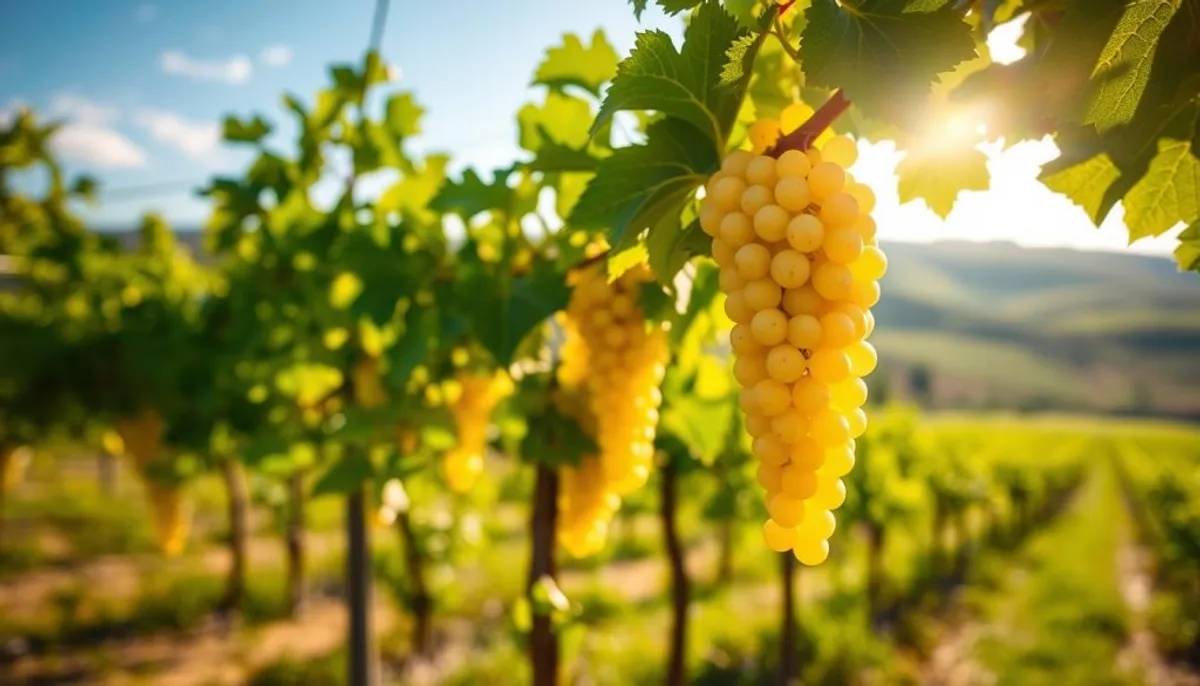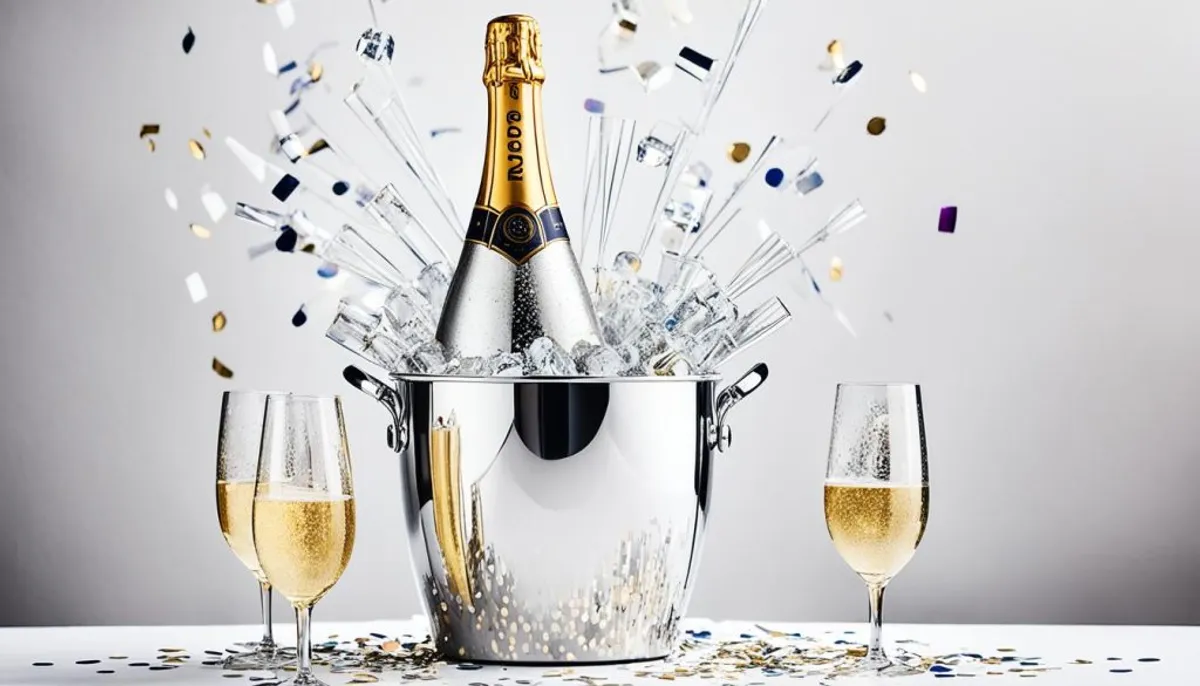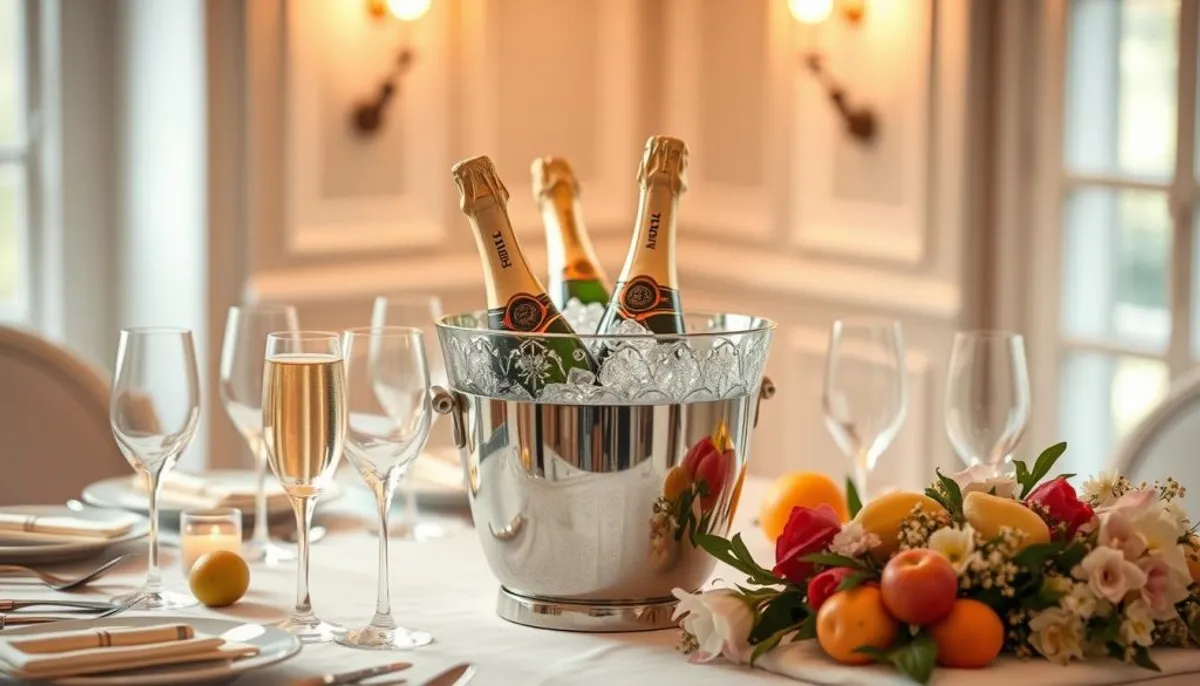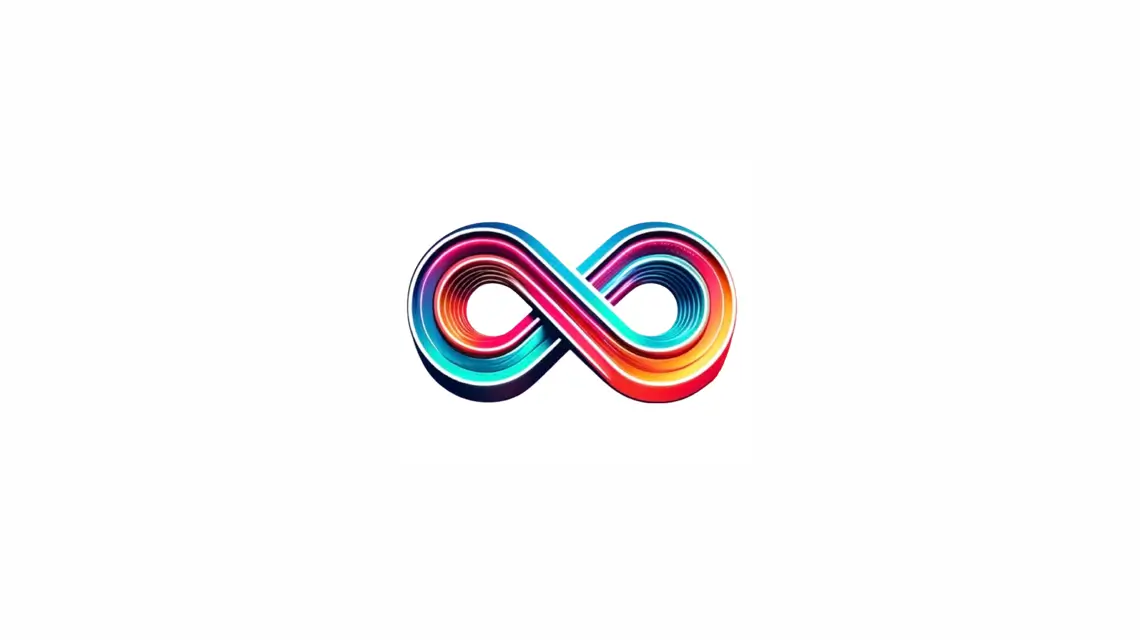Champagne Chardonnay stands as a quintessential element of French sparkling wine, offering a delightful experience for any celebration. This premium champagne, crafted from Chardonnay grapes, represents 30% of Champagne plantings. The Côte des Blancs region, renowned for its chalky soils, provides the perfect terroir for these grapes to thrive.
Chardonnay brings a unique character to champagne. It adds brightness, minerality, and crisp acidity to the blend. The result? A celebratory drink that dances on your palate with citrus notes and hints of apple, pear, and white peach. For those looking to elevate their celebrations, a champagne tasting for new years can be a delightful experience.

While Chardonnay matures slower than its Pinot cousins, it boasts excellent aging potential. This trait allows wine enthusiasts to enjoy vintage Champagne Chardonnays that have developed complex flavors over time. From the fresh, light Blanc de Blancs to the depth of high Pinot Noir blends, there’s a Champagne Chardonnay for every taste and occasion.
Key Takeaways
- Chardonnay makes up 30% of Champagne plantings
- The Côte des Blancs region is prime for Chardonnay cultivation
- Champagne Chardonnay offers citrus and white fruit flavors
- Blanc de Blancs champagnes are made solely from Chardonnay
- Some houses use up to 80% Chardonnay in their blends
- Chardonnay contributes to the champagne’s aging potential
Understanding Champagne Chardonnay’s Legacy in French Winemaking
Chardonnay is pivotal in French winemaking, notably in the Champagne region. Spanning 210,000 hectares across 41 countries, it exemplifies global popularity. In Champagne, it is a cornerstone in the creation of esteemed sparkling wines.
The Historical Significance of Chardonnay in Champagne
The introduction of Chardonnay to Champagne traces back to Cistercian monks. Their efforts in disseminating the grape across France laid the groundwork for its prominence. Chardonnay’s capacity to reflect its terroir results in a spectrum of flavors. This versatility is crucial for capturing the essence of Champagne’s unique terroir.
The Côte des Blancs Region’s Influence
The Côte des Blancs, distinguished by its chalky, mineral-rich soils, is renowned for producing superior Chardonnay grapes. This region’s contribution is evident in the elegance and finesse of many Champagnes. Blanc de Blancs, crafted solely from Chardonnay, presents a light, crisp profile with citrus and floral undertones.
Traditional Production Methods
Champagne’s traditional winemaking techniques heavily rely on Chardonnay. The grape’s early budding and moderate ripening facilitate the development of complex flavors. The focus on lower yields ensures more concentrated flavors, necessitating meticulous vineyard management. In blends, Chardonnay’s acidity, freshness, and structure counterbalance the bold fruit notes from other grapes.
| Characteristic | Chardonnay’s Contribution to Champagne |
|---|---|
| Acidity | Provides freshness and balance |
| Aging Potential | Enhances longevity of the wine |
| Aroma | Adds citrus and floral notes |
| Structure | Contributes to the wine’s body |
The Art of Champagne Chardonnay Production
Champagne production is a meticulous craft that combines tradition with innovation. The winemaking techniques used in creating Champagne Chardonnay showcase the grape’s versatility and elegance. Chardonnay, representing 30% of Champagne vineyards, plays a crucial role in crafting these sparkling wines.
The journey begins with careful grape selection and sorting. Winemakers then employ the traditional method, which involves a second fermentation in bottles. This process contributes to the wine’s complexity and character, often taking years to develop fully.
Grape blending is an essential step in Champagne production. While some producers create Blanc de Blancs using 100% Chardonnay, others mix it with Pinot Noir and Pinot Meunier. The Cellar Master’s expertise shines during this stage, combining up to fifty different wines to achieve the perfect blend.
After blending, the bottles undergo riddling, a process that collects yeast in the bottle neck. This is followed by disgorgement and the addition of dosage for flavor balance. The entire production cycle can last six years or more, resulting in wines of exceptional quality and aging potential.
| Grape Variety | Percentage in Champagne Vineyards | Common Use |
|---|---|---|
| Chardonnay | 30% | Blanc de Blancs, blending |
| Pinot Noir | 38% | Blending, Blanc de Noirs |
| Pinot Meunier | 31% | Blending, Blanc de Noirs |
Characteristics of Premium Champagne Chardonnay
Premium Champagne Chardonnay stands out with its unique traits. This grape variety, influenced by its terroir, exhibits diverse personalities. The Côte des Blancs, known for its chalky soil, is renowned for producing exceptional Chardonnay grapes. These grapes are crucial for crafting many esteemed cuvées.
Aroma and Flavor Profile
The aroma of Premium Champagne Chardonnay is enchanting. It often features white flower, citrus, and toasted notes. On the palate, these wines offer a harmonious blend of minerality and acidity. As they mature, they develop richer, nuttier flavors and a more refined finish.
Aging Potential and Development
Chardonnay-based Champagnes exhibit remarkable aging potential. Over time, they gain complexity and depth. Vintage Champagnes, aged for at least three years, exemplify this evolution. Non-vintage options, aged for 15-18 months, provide a preview of this transformation. For those seeking the best bubbly offers, these options are truly exceptional.
Visual and Tasting Notes
When evaluating Premium Champagne Chardonnay, consider these tasting notes:
- Color: Ranges from pale green to lemon yellow
- Bubbles: Persistent and fine
- Aroma: White flowers, citrus, toast
- Flavor: Mineral, crisp acidity, subtle creaminess
- Finish: Long and elegant
| Sweetness Level | Sugar Content (g/L) | Taste Profile |
|---|---|---|
| Brut Nature | <3 | Bone dry |
| Extra Brut | <6 | Very dry |
| Brut | <12 | Dry |
| Extra Sec | 12-17 | Off-dry |
| Sec | 17-32 | Slightly sweet |
Blanc de Blancs: The Pure Expression of Chardonnay

Blanc de Blancs champagne embodies the essence of Chardonnay. This 100% Chardonnay champagne highlights the grape’s elegance and finesse. Despite Chardonnay’s limited contribution to Champagne’s total supply, it is pivotal in crafting these exceptional wines.
The Côte des Blancs region, notably Mesnil-sur-Oger, is celebrated for its high-quality Chardonnay grapes. Vineyards here, situated between 120 to 230 meters above sea level, and with slopes reaching up to 45 degrees, contribute unique characteristics to the grapes.
Blanc de Blancs from this area are distinguished by their minerality, refreshing acidity, and aging potential. An outdoor champagne photoshoot in the picturesque vineyards can capture the essence of these exceptional wines. Renowned champagne houses, such as Ruinart, Salon, and Louis Roederer, produce outstanding Blanc de Blancs cuvées.
| Producer | Cuvée | Aging Potential | Quality Rating |
|---|---|---|---|
| Salon | Cuvée S | 10+ years | Outstanding |
| Taittinger | Comtes de Champagne | 7-10 years | Excellent |
| Ruinart | Blanc de Blancs | 5-7 years | Excellent |
| Louis Roederer | Cristal | 10+ years | Outstanding |
Blanc de Blancs champagnes complement seafood, aged cheeses, and poultry dishes, making them a perfect choice to pair with new years champagne. Their versatility and aging potential make them a cherished choice among champagne aficionados and collectors.
Top Champagne Houses Known for Chardonnay Excellence
Champagne brands have long celebrated the art of crafting exceptional Chardonnay-based wines. From prestigious houses to boutique champagne producers, the region boasts a rich tapestry of styles and traditions.
Taittinger’s Chardonnay Mastery
Taittinger stands out for its commitment to Chardonnay excellence. Founded in 1734, this family-owned house offers tours starting at €40. Visitors can explore their chalk cellars and taste their refined Blanc de Blancs. Taittinger’s signature style emphasizes elegance and finesse, making it a favorite among Chardonnay enthusiasts.
Ruinart’s Signature Style
Ruinart, the oldest established champagne house dating back to 1729, is renowned for its Chardonnay-focused cuvées. Tours of their historic cellars begin at €90, offering a glimpse into their winemaking philosophy. Ruinart’s Blanc de Blancs exemplifies the house’s dedication to purity and freshness in Chardonnay expression.
Smaller Boutique Producers
Boutique champagne makers are gaining recognition for their innovative approaches to Chardonnay. Houses like Jacquesson focus on terroir-driven wines with minimal intervention, creating expressive Chardonnay champagnes that reflect their unique origins. These smaller producers often offer intimate tasting experiences, providing a personal touch to champagne appreciation.
| Champagne House | Founding Year | Tour Starting Price |
|---|---|---|
| Taittinger | 1734 | €40 |
| Ruinart | 1729 | €90 |
| Jacquesson | 1798 | Varies |
Pairing Your Champagne Chardonnay with Food
Champagne Chardonnay opens a realm of gourmet pairings, enhancing any dining occasion. Its versatility makes it an ideal match for a variety of dishes, from light seafood to rich, creamy entrees.
For a quintessential pairing, consider Champagne Chardonnay with oysters. The wine’s effervescence serves as a palate cleanser, amplifying the oysters’ briny essence. Seafood aficionados will find the wine’s acidity perfectly complements steamed lobster or delicate sole meunière.
For those seeking novel pairings, the wine’s crisp notes can balance the richness of fried chicken or elevate a simple peanut butter and jelly sandwich to new heights.
| Dish | Pairing Notes |
|---|---|
| Grilled Tomahawk Ribeye | Enhances umami flavors |
| Caviar | Complements salty, buttery notes |
| Creamy Pasta | Balances richness |
| Fresh Berries | Perfect with Rosé Champagne |
For the ultimate indulgence, pair your Champagne Chardonnay with Japanese Wagyu A5 grade beef. The wine’s effervescence cuts through the meat’s richness, creating a harmonious blend of flavors that epitomizes fine dining.
Investment Worthy Champagne Chardonnay Selections
Champagne Chardonnay has emerged as a prime choice for those looking to invest in wine. The market has witnessed a notable surge, with vintage champagne prices experiencing a significant rise. This growth underscores the importance of certain Champagne Chardonnays as valuable investments.
Vintage Considerations
When delving into Champagne Chardonnay investment, the vintage year plays a pivotal role. Years that stand out for their quality and aging potential are highly sought after. The 2008 vintage, for instance, has garnered significant attention for its exceptional quality and potential for appreciation.
| Vintage | Notable Champagne | Price Range |
|---|---|---|
| 2008 | Louis Roederer Cristal | $300-$450 |
| 2012 | Dom Pérignon | $166-$200 |
| 2003 | Dom Pérignon Plénitude 2 | $300-$450 |
Storage Requirements
Ensuring proper storage is paramount for preserving and enhancing the value of champagne. Bottles should be stored horizontally in a cool, dark environment with consistent temperature and humidity levels. Professional storage facilities provide the ideal conditions for long-term investment.
Value Appreciation
The Champagne market has demonstrated remarkable growth. In the recent past, top champagnes have outperformed even Burgundy wines. Certain vintage Champagne Chardonnays have experienced substantial price increases, making them appealing for wine investment portfolios. Additionally, the rise of top punjabi hits in popular culture has also influenced the wine market, drawing in new investors and enthusiasts alike.
Despite the current fervor in the Champagne market, experts warn of potential overheating. Economic uncertainty and geopolitical issues could influence future performance. Investors are advised to conduct thorough research and consider diversifying their wine investment strategy.
Serving and Temperature Guidelines
Mastering the art of champagne serving is essential for fully appreciating its nuances. The ideal serving temperature for Champagne Chardonnay lies between 45-50°F (7-10°C). This temperature range accentuates the wine’s crisp flavors and effervescence.

The selection of champagne glasses significantly impacts the tasting experience. Opt for fine crystal flutes with a capacity of 10-18 ounces. These glasses are designed to preserve the bubbles and concentrate the aromas, thus enhancing the overall enjoyment of your Champagne Chardonnay.
| Wine Type | Serving Temperature (°F) | Serving Temperature (°C) |
|---|---|---|
| Sparkling Wine | 40-46°F | 5-8°C |
| Light White Wine | 44-50°F | 7-10°C |
| Full-Bodied White Wine | 50-55°F | 10-12°C |
The ideal pour volume is about 5 ounces, filling the glass halfway. This allows for the bubbles to develop and the aromas to concentrate. For parties, plan for one bottle per hour for every two guests when serving alongside other beverages.
Proper storage is paramount. An open bottle of Champagne Chardonnay can be kept upright in the refrigerator for up to two days without compromising its taste. For longer-term storage, maintaining a consistent cool temperature is essential to preserve the wine’s quality.
Seasonal Selection Guide for Champagne Chardonnay
Champagne Chardonnay stands out as a versatile choice for various celebrations. It’s essential to select the right Champagne Chardonnay for different seasons and occasions. This guide will help you navigate through the best options for each time of year and special events.
Summer Celebrations
In the summer, lighter Champagne Chardonnays are ideal. These crisp, refreshing styles are perfect for warm weather and outdoor events, especially when paired with luxury event rentals. Ensure they are well-chilled to maintain their lively essence. Blanc de Blancs Champagnes, crafted solely from Chardonnay grapes, are the quintessential summer selection.
Winter Festivities
Winter demands richer, more complex Champagne Chardonnays. These varieties, with their aged characteristics, offer deeper flavors that complement hearty holiday meals. Their robust body and intricate taste profiles are well-suited to the season’s rich cuisine.
Special Occasions
For significant events, consider prestigious Blanc de Blancs Champagnes. Their elegance and sophistication make them ideal for toasts at weddings, anniversaries, or New Year’s Eve celebrations.
| Season | Champagne Chardonnay Style | Pairing Suggestion |
|---|---|---|
| Spring | Light, crisp Blanc de Blancs | Fresh salads, light appetizers |
| Summer | Unoaked, refreshing styles | Seafood, grilled vegetables |
| Fall | Medium-bodied, slightly aged | Roasted poultry, creamy pastas |
| Winter | Full-bodied, complex vintages | Rich holiday dishes, aged cheeses |
The ideal Champagne Chardonnay for your celebration hinges on personal taste and the occasion. Exploring different styles across seasons can uncover delightful discoveries in the realm of these exquisite celebration drinks.
Budget-Friendly Champagne Chardonnay Options
Exploring quality Champagne Chardonnay doesn’t necessitate a significant financial investment. The realm of value champagne presents a plethora of delightful options for those in pursuit of affordable luxury. We will examine some premier selections for champagne under $50, offering exceptional taste without the exorbitant cost.
In the $30-$50 bracket, introductory Champagnes emerge, highlighting the sophistication of Chardonnay. Brands such as Paul Laurent and Piper-Heidsieck exemplify outstanding quality-to-price ratios. This allows for the enjoyment of premium Champagne Chardonnay without depleting one’s financial resources.
For those eager to broaden their horizons, consider these alternatives:
- Crémant d’Alsace: Wineries like Frey-Sohler and Pierre Sparr produce sparkling wines that rival Champagne at a fraction of the cost.
- Trento DOC: Italian producers such as Cesarini Sforza craft 100% Chardonnay sparkling wines using the traditional method.
- New World Options: Gruet Sauvage from New Mexico and Jansz from Tasmania offer surprising value under $30.
It’s important to note that while vintage Champagne necessitates a minimum of 36 months aging, non-vintage options can provide great value. By venturing into these affordable champagne alternatives, one can partake in the splendor of sparkling Chardonnay without financial strain.
Sustainable and Biodynamic Champagne Production
The Champagne region is embracing eco-friendly production methods. Sustainable winemaking practices are gaining traction, with about 2% of Champagne vineyards now following biodynamic principles. This shift reflects a growing commitment to environmental stewardship in the wine industry.
Environmental Impact
Biodynamic champagne production focuses on maintaining biodiversity and reducing carbon footprint. Some producers, like Maison Les Cinq Filles, operate in historic buildings and aim for carbon-neutral operations. These practices help preserve the unique terroir of Champagne while minimizing ecological impact.
Modern Practices
Innovative winemakers are adopting sustainable and biodynamic methods to enhance terroir expression. For example, Yvonne Seier Christensen, a qualified vintner, uses these techniques in her Avize vineyard. Some producers even employ traditional horse-drawn ploughs, blending heritage with eco-friendly approaches.
Future Trends
The future of Champagne production leans towards sustainability. Despite challenges like cool weather and heavy rainfall, biodynamic champagnes are gaining popularity. These wines often feature low or zero dosage, appealing to health-conscious consumers with fewer calories per glass. As demand grows, we can expect more Champagne houses to adopt these environmentally responsible practices.
| Aspect | Conventional | Biodynamic |
|---|---|---|
| Vineyard Management | Chemical inputs | Natural preparations |
| Biodiversity | Limited | Encouraged |
| Carbon Footprint | Higher | Lower |
| Terroir Expression | Moderate | Enhanced |
Conclusion
Champagne Chardonnay is a pivotal element in the sparkling wine universe. Its adaptability is evident in the array of styles, ranging from the sharp, mineral-rich Blanc de Blancs of Côte des Blancs to the opulent, layered wines from Côte des Bar. This variety caters to a broad spectrum of preferences and events.
The rise in Chardonnay’s popularity is clear, with its cultivation area expanding significantly. In California, for instance, Chardonnay plantings skyrocketed from 986 acres in 1968 to over 100,000 acres by the early 2000s. This surge surpasses France’s total Chardonnay cultivation, highlighting the grape’s global appeal.
Embarking on a journey through Champagne Chardonnay is a profound exploration for both aficionados and newcomers. It encompasses a spectrum of flavors, from the zesty, citrusy notes of youthful wines to the rich, toasty scents of aged ones. For those eager to explore the realm of champagne export, numerous resources are available. They guide you through the selection process, ensuring you find the ideal bottle for any celebration.
RelatedRelated articles



